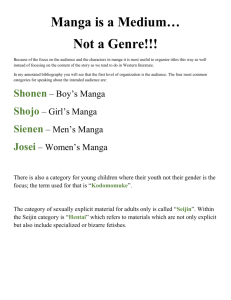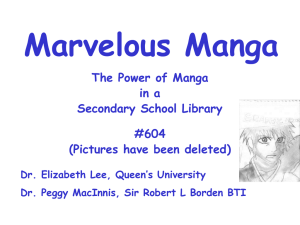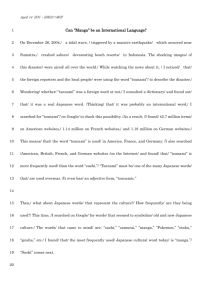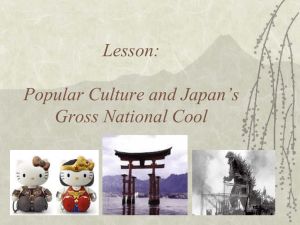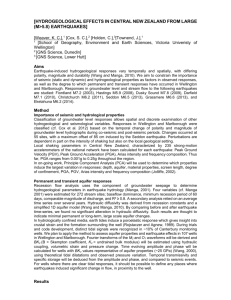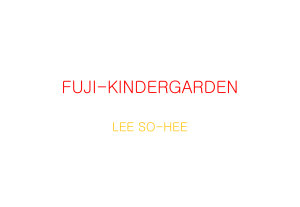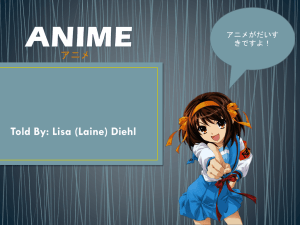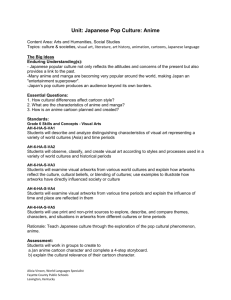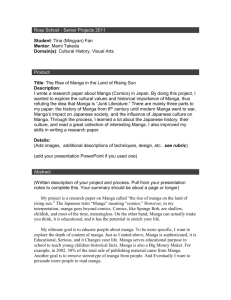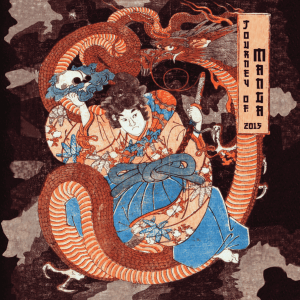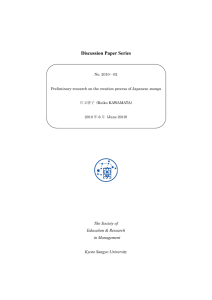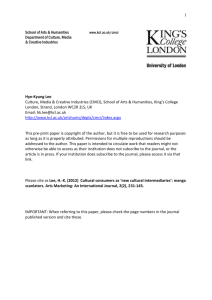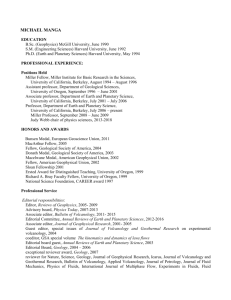Press Release - Etihad Modern Art Gallery
advertisement
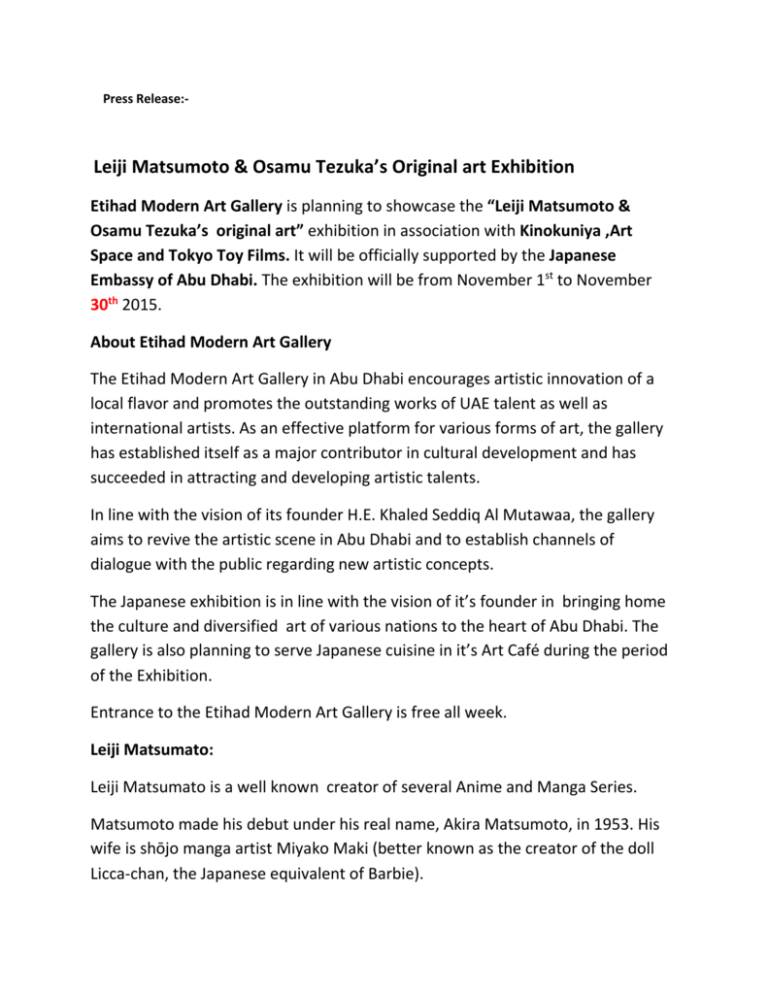
Press Release:- Leiji Matsumoto & Osamu Tezuka’s Original art Exhibition Etihad Modern Art Gallery is planning to showcase the “Leiji Matsumoto & Osamu Tezuka’s original art” exhibition in association with Kinokuniya ,Art Space and Tokyo Toy Films. It will be officially supported by the Japanese Embassy of Abu Dhabi. The exhibition will be from November 1st to November 30th 2015. About Etihad Modern Art Gallery The Etihad Modern Art Gallery in Abu Dhabi encourages artistic innovation of a local flavor and promotes the outstanding works of UAE talent as well as international artists. As an effective platform for various forms of art, the gallery has established itself as a major contributor in cultural development and has succeeded in attracting and developing artistic talents. In line with the vision of its founder H.E. Khaled Seddiq Al Mutawaa, the gallery aims to revive the artistic scene in Abu Dhabi and to establish channels of dialogue with the public regarding new artistic concepts. The Japanese exhibition is in line with the vision of it’s founder in bringing home the culture and diversified art of various nations to the heart of Abu Dhabi. The gallery is also planning to serve Japanese cuisine in it’s Art Café during the period of the Exhibition. Entrance to the Etihad Modern Art Gallery is free all week. Leiji Matsumato: Leiji Matsumato is a well known creator of several Anime and Manga Series. Matsumoto made his debut under his real name, Akira Matsumoto, in 1953. His wife is shōjo manga artist Miyako Maki (better known as the creator of the doll Licca-chan, the Japanese equivalent of Barbie). Matsumoto had his big break with Otoko Oidon, a series that chronicled the life of a rōnin (a young man preparing for university entrance exams), in 1971. Around the same time he started a series of unconnected short stories set during World War II, Senjo Manga Series, which would eventually become popular under the title The Cockpit. He was involved in Space Battleship Yamato (1974) and created the highly popular series Space Pirate Captain Harlock and Galaxy Express 999 (both 1977). In 1978, he was awarded the Shogakukan Manga Award for shōnen for Galaxy Express 999 and Senjo Manga Series.[4] Animated versions of Captain Harlock and Galaxy Express 999 are set in the same universe, which spanned several spin offs and related series, most notably Queen Emeraldas and Queen Millennia. Works of Matsumoto:Arei no Kagami (1985) Fairy Hotaruna Space Battleship Yamato (1974) Planet Robot Danguard Ace (part of the U.S. Force Five anthology series, as Dangard Ace; 1977–1978) Galaxy Express 999 (1977–1981) Space Pirate Captain Harlock (1977–1979) Starzinger (part of the Force Five anthology series, as Spaceketeers) (1978–1979) Queen Millennia (aka Queen of 1000 Years) Arcadia of My Youth Arcadia of My Youth: Endless Orbit SSX The Cockpit Maeterlinck's Blue Bird: Tyltyl and Mytyl's Adventurous Journey Queen Emeraldas Tiger-Striped Mii The Ultimate Time Sweeper Mahoroba (manga) Fire Force DNAsights 999.9 Harlock Saga Der Ring des Nibelungen Maetel Legend Cosmo Warrior Zero Gun Frontier (1972–1975) Great Galaxy (formerly Great Yamato) Pu Pu (1974) Interstella 5555: The 5tory of the 5ecret 5tar 5ystem (2003) (In cooperation with Daft Punk) The Galaxy Railways Great Yamato #0 Space Symphony Maetel Submarine Super 99 (1964) Kousoku Esper (1968–1970) Sexaroid (1968–1970) Machinner series (1969–1970) Mystery Eve (1970–1971) Dai-yojo-han series (1970–1974) Otoko Oidon (1971–73) Senjo Manga series (1973–1978) Insect (1975) Saint Elmo – Hikari no Raihousha Ozuma Osamu Tezuka: METROPOLIS is a 2001 anime film loosely based on the 1949 Metropolis manga created by Osamu Tezuka, itself inspired by the 1927 German silent film of the same name, though the two do not share plot elements. The anime, however, does draw aspects of its storyline directly from the 1927 film. The anime had an all-star production team, including renowned anime director Rintaro, Akira creator Katsuhiro Otomo as script writer, and animation by Madhouse with conceptual support from Tezuka Productions. Differences between manga and anime:In Tezuka's original manga, the story revolves around a humanoid named Mitchi, who has the ability to fly and change gender. Mitchi is pursued by Duke Red and his "Red Party" who intend to use Mitchi for destructive purposes. However, Shunsaku Ban and his nephew Kenichi find Mitchi after her creator, Dr. Charles Laughton, is killed and protect her as they search for her parents. Unlike Tima's desire to be human, the cause for Mitchi's destructive rampage in the manga's climax is the revelation that, as a robot, she does not have parents. However, this cinematic adaptation of Tezuka's story integrates far more elements from the Fritz Lang film Metropolis.[2] When making the original Metropolis manga, Tezuka said that the only real inspiration he got from Fritz Lang's Metropolis was a still image from the movie where a female robot was being born.[3] In addition to adopting set designs of the original film, this version has more emphasis on a strong and pervasive theme of class struggle in a dystopian, plutocratic society and expands it to examine the relationship of robots with their human masters. (This relationship was explored by Tezuka in great detail with his popular series Astro Boy.) The anime adaptation also removes many of the more fanciful elements out of Tezuka's manga, such as a flying, gender swapping humanoid. Here, Mitchi is replaced by "Tima", who is permanently female and cannot fly.
